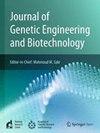利用农业形态特征和ISSR技术评价土藓属植物的遗传多样性及群体结构
IF 2.8
Q3 Biochemistry, Genetics and Molecular Biology
Journal of Genetic Engineering and Biotechnology
Pub Date : 2025-05-08
DOI:10.1016/j.jgeb.2025.100500
引用次数: 0
摘要
利用农艺性状和ISSR标记对36份绵草材料的遗传多样性和群体结构进行了评价。农艺性状和ISSR标记显示出了广泛的遗传多样性。千粒重与总蛋白率的显著相关表明,这两个性状在独立的遗传控制下。标记产生的等位基因总数为336个,多态性为100%。标记的多态信息含量(PIC)、有效复形比(EMR)、标记指数(MI)和分辨能力(RP)分别为0.75、16.46、17.83和2.70,表明各品种间存在较大差异。AMOVA检验表明,93%的遗传变异发生在种质内,7%发生在种质间。eowens - watterson中性检验表明,9个标记均为中性,除保加利亚的Lathyrus apaca外,大部分遗传多样性存在于材料中,证实了AMOVA结果。遗传多样性(h)和香农信息指数(Shannon’s information index)分别为0.34和0.52,表明亲本OPA01-812是高推荐品种。品种间遗传分化(GST)为0.03,而基于Wright方程的每代迁移数(Nmw)为18.12。然而,9个标记的卡方值的概率(P)大于0.05,表明调查材料之间的异质性较低。ISSR聚类分析和对应分析结果表明,山楂种质资源的遗传多样性不受地理来源的影响。他们还揭示了红枫和青枫并非来自同一祖先。综上所述,我们推荐(1)选用高产、低β-ODAP百分比的沙草PI 179299作为选育新品种;(2)选用ISSR标记作为沙草品种间的鉴定和区分。本文章由计算机程序翻译,如有差异,请以英文原文为准。
Evaluation of genetic diversity and elucidation of population structure of Lathyrus accessions using agro-morphological characters and ISSR technique
Genetic diversity and population structure were evaluated for 36 Lathyrus L. accessions using agronomic characters and ISSR markers. The agronomic characters and ISSR markers showed a wide genetic diversity between Lathyrus accessions. The significant association between 1000 seed weight and total seed protein percentage in Lathyrus accessions revealed that both characters were under independent genetic control. The total number of alleles generated by the markers was 336, revealing 100% polymorphism. The polymorphic information content (PIC), effective multiplex ratio (EMR), marker index (MI), and resolving power (RP) of the markers were 0.75, 16.46, 17.83, and 2.70, respectively, confirming the great variation in Lathyrus accessions. The AMOVA test indicated that 93% of all genetic variation was found within accessions and 7% between accessions. The Ewens–Watterson test for neutrality indicated that the nine markers were neutral, and most of the genetic diversity resided in accessions, with the exception of Lathyrus aphaca from Bulgaria, confirming AMOVA results. The genetic diversity (h) and Shannon’s information index were 0.34 and 0.52, respectively, revealing that maker OPA01-812 was highly recommended for distinguishing Lathyrus accessions. The genetic differentiation among accessions (GST) was 0.03, whereas the number of migrants per generation based on Wright’s equation (Nmw) was 18.12. However, the probability (P) of the chi-square values exceeded 0.05 for the nine markers, indicating the low heterogeneity between the investigated accessions. Cluster and correspondence analyses for ISSR results showed that the genetic diversity among Lathyrus accessions was not influenced by their geographical origin. They also revealed that Lathyrus sativus and Lathyrus cicera were not derived from the same ancestor. In conclusion, we recommended (1) Lathyrus sativus PI 179299 for breeding for new cultivars with a high yield and low β-ODAP percentage and (2) ISSR markers for characterizing and differentiating between Lathyrus accessions.
求助全文
通过发布文献求助,成功后即可免费获取论文全文。
去求助
来源期刊

Journal of Genetic Engineering and Biotechnology
Biochemistry, Genetics and Molecular Biology-Biotechnology
CiteScore
5.70
自引率
5.70%
发文量
159
审稿时长
16 weeks
期刊介绍:
Journal of genetic engineering and biotechnology is devoted to rapid publication of full-length research papers that leads to significant contribution in advancing knowledge in genetic engineering and biotechnology and provide novel perspectives in this research area. JGEB includes all major themes related to genetic engineering and recombinant DNA. The area of interest of JGEB includes but not restricted to: •Plant genetics •Animal genetics •Bacterial enzymes •Agricultural Biotechnology, •Biochemistry, •Biophysics, •Bioinformatics, •Environmental Biotechnology, •Industrial Biotechnology, •Microbial biotechnology, •Medical Biotechnology, •Bioenergy, Biosafety, •Biosecurity, •Bioethics, •GMOS, •Genomic, •Proteomic JGEB accepts
 求助内容:
求助内容: 应助结果提醒方式:
应助结果提醒方式:


